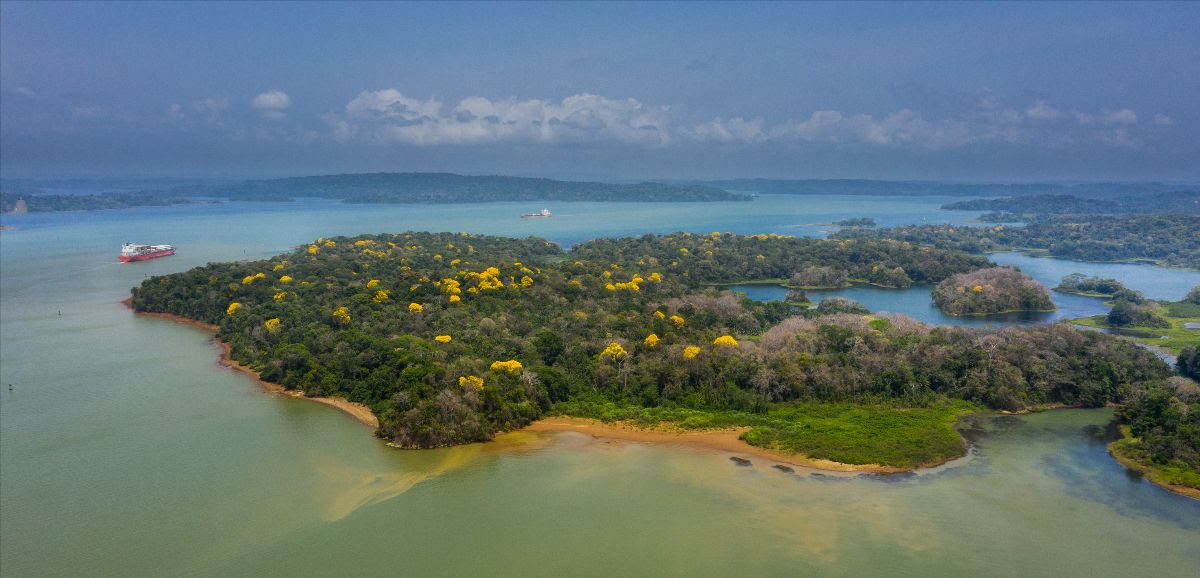

Maritime trade in the Americas before the Panama Canal opened 107 years ago required sailing around Cape Horn, the southernmost tip of South America, a voyage that could take up to two months. Today, sailing from US East Coast to Asia through the Panama Canal takes approximately 26 days, compared to 43 days for voyages through Cape Horn, 37 days through Cape of Good Hope, or 33 days if transiting through the Suez Canal.
Today, the Canal has facilitated more than 1.1 million transits, connecting more than 180 maritime routes, and 1,920 ports in 170 countries. It has also grown to serve as the Green Route by continuously expanding its environmental protections, incentives and offerings as a more sustainable option for shipping lines. Since its opening in 1914, the Canal has contributed to the reduction of more than 850 million tons of carbon dioxide (CO2) through its service to shipping lines.
As we look ahead to the future, take a look back at key moments in the Canal’s 107-year history:
AUGUST 15, 1914 – The Inauguration of the Panama Canal
The Panama Canal opens to the world with the transit of the SS Ancon transiting from the Atlantic to the Pacific. Two hundred people were on board, including Captain John Constantine and the President of Panama, Belisario Porras.
MAY 12, 1963 – 24/7 Operation
The Panama Canal starts operations 24 hours a day, seven days a week. This was made possible with the installation of fluorescent lighting at the locks and the Culebra Cut, allowing night transits and increasing overall transits to the waterway.
Did You Know? On September 4, 2010, the bulk carrier Fortune Plum became the millionth transit through the Canal.
SEPTEMBER 7, 1977 – The Torrijos-Carter Treaties
The United States and the Republic of Panama sign the Torrijos-Carter Treaties, setting the stage for the transfer of the Panama Canal from United States to Panamanian administration in 1999.
FEBRUARY 16, 1994 – Seven Wonders of the Modern World
The Panama Canal is named one of the seven wonders of the modern world by the American Society of Civil Engineers (ASCE).
DECEMBER 31, 1999 – A Panamanian Administration
Panama takes on the administration and operation of the Canal. Since its transfer, the Panama Canal has been focused on improving the quality of its service and the safety and reliability of the route to offer a competitive service to global trade.
Did You Know? Every year, the Panama Canal spends more than $250 million in its maintenance program and invests roughly $200 million in projects ranging from replacing floating equipment to modernizing critical infrastructure and beyond.
SEPTEMBER 3, 2007 – Construction of the Expanded Canal Begins
Construction of the Expanded Canal begins, prompting investments in similar expansion projects around the world, particularly at seaports located along the U.S. East Coast, to take advantage of the forthcoming increase in traffic. The blast in Paraiso Hill (pictured above) signaled the breaking ground and beginning of the Expansion Program.
JUNE 26, 2016 – Expanded Canal Inauguration
The Expanded Canal is inaugurated with the transit of the COSCO Shipping Panama, creating a new lane for the transit of Neopanamax vessels and doubling the cargo capacity of the waterway.
Did You Know? The Panama Canal is responsible for the management, maintenance, use and conservation of the water resources of its surrounding watershed. The Canal also helps protect the Panama Canal watershed’s overall sustainable development and ecosystem in partnership with local communities and partners, such as the Smithsonian Tropical Research Institute.
DECEMBER 27, 2020 – The Largest Capacity Vessel Transits
The CMA CGM Argentina, with a 15,846 Total TEU allowance, transits through the Neopanamax Locks, as the largest capacity vessel to date.
APRIL 26, 2021 – Carbon Neutral by 2030
The Panama Canal initiates the process of becoming a carbon neutral organization by 2030.
Source: Panama Canal Authority






